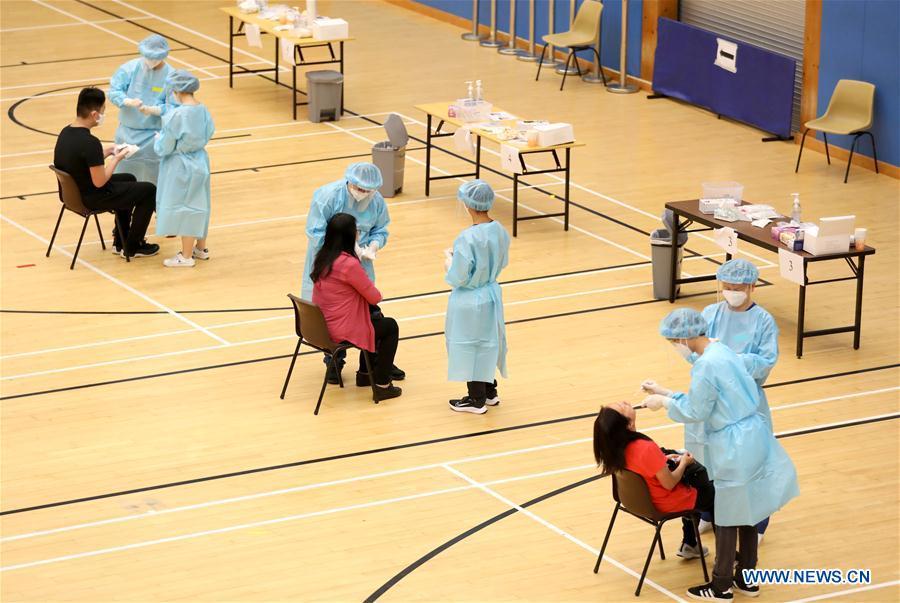Opinion | Political disputes must be put aside to fight virus together

By Chow Pak-chin
To break the COVID-19 contagious chain, more than 1.7 million Hong Kong people have taken part in the voluntary Universal Community Testing Programme, which was launched on Sept. 1.
Though the program has been concluded, there are still several questions that some members of the public — and various naysayers — are still asking: Has the program been successful? Will it end the third wave that is still haunting Hong Kong? Have we identified enough asymptomatic carriers to make a difference?
Let us first examine a few figures.
In Hong Kong, we have reported just about 5,000 confirmed cases since late January, and 101 have died; this means our death rate is about 2 percent.
In comparison to Western nations like Britain and the United States, Hong Kong's death rate — measured by the number of deaths against the number of confirmed cases — is low.
However, when we compare this percentage against our neighbors like Singapore, Taiwan, and South Korea, we aren't doing so well.
Some attribute this figure to our larger gray population, who have been particularly affected by Hong Kong's third wave of infections. A number of elderly homes in the city have been reported as COVID-19 hot spots, and given that the elderly are particularly vulnerable to the coronavirus, it is no surprise that our death rate is higher.
Among some 700-plus cities across China, Hong Kong has one of the highest death rates. It goes without saying that Wuhan — the city that first reported COVID-19 — reported one of the highest death rates in China, but it is not that far ahead of Hong Kong.
So how is it that Hong Kong, a first-rate world city and a global economic powerhouse, has not done as well as expected in managing the virus and protecting its population?
Some have speculated that the freedom that Hong Kong people cherish has allowed the virus to fester as it has spread among our population. As an example, testing was not compulsory.
The goal of the community testing program was to test as many in the population as possible, to allow the program to compile a usable and effective database that would be able to identify more invisible carriers within the population.
But it is clear that 1.7 million test subjects are a significantly large shortfall and therefore a suboptimal result.
By Sunday, we were only able to trace 21 asymptomatic carriers among the 26 identified cases out of the 1.7 million people who took part in the program.
While we can say that have been able to break some chains of infection, there are still a number of asymptomatic carriers out there who are unknowingly spreading COVID-19 among the city's population.
According to Professor Ivan Hung Fan-ngai, clinical professor and assistant dean for the Department of Medicine at the University of Hong Kong, it is highly likely that there are 40 to 50 invisible carriers that have yet to be identified. Furthermore, it may take at least another six weeks for the city to return to zero new cases a day.
Obviously, naysayers were quick to jump on the bandwagon to discredit the testing program and its perceived failures.
But why did the program fail to reach a larger segment of the community?
Public awareness may have been an issue, as the exact procedure of the initiative was not publicized as widely as expected ideally. Furthermore, any undue fears and concerns that the public had were not properly, if at all, addressed in the little publicity that the program received.
The Hospital Authority Employees Alliance, with its usual political bias against the government, was one of the more prominent groups that opposed the program and called for its boycott, citing concerns that crowded test centers would raise the risk of infection.
The opposition camp was also quick to point out the so-called high cost of the program for the taxpayers.
According to them, the program has cost us HK$100 million (US$12.9 million). The true cost of the program for taxpayers has yet to be officially announced.
But politics aside, whatever the cost, we can't deny that the program has had a positive effect in combating COVID-19, and by extension, a positive effect on our economy. And as a doctor, I hold that health and life are priceless treasures that cannot be measured by money.
Tourism has suffered heavily at the hands of the pandemic, and so have our local restaurants, bars, cafes, and other dining establishments. We can't deny that the identification of the asymptomatic carriers within our community has allowed many of us to breathe a little easier, so to speak.
There is still much to be done to restimulate our moribund economy, but perhaps Hong Kong can begin to heal and continue to fight the good fight against not just invisible enemies, but enemies within our community who remain determined in undermining government efforts without offering any solutions, making use of their usual scaremongering tactics.
Let us express our most heartfelt gratitude to those who have not only donated time and effort into making the testing program possible, but those who put their lives on the front lines and left their families behind.
The central government provided the financial and medical support for the program. More importantly, the 600-strong nucleic acid test support team who came from the Chinese mainland to Hong Kong to run and manage the program are the front-line heroes who undoubtedly deserve the most praise.
We are deeply grateful for the care shown by these medical personnel who displayed not only professionalism, but courage and selflessness in coming to the aid of us Hong Kong residents, even against the backdrop of political and public skepticism and, dare I say, hostility.
It is safe to say that we have, now, just begun to win a battle against the third-wave COVID-19 outbreak, but we have yet to declare the end of the war against it.
Perhaps most importantly, we as a community need to find a way to put aside our differences, particularly political differences, and come together as one to put an end to this invisible enemy once and for all.
We all want the same thing, a healthy, safe, and ultimately prosperous and happy city — that means we must find a way to achieve our common goal. We shall be stronger when we stand together.
(Source: China Daily)
The author is president of Wisdom Hong Kong, a local think tank. The views don't necessarily reflect those of DotDotNews.








Comment